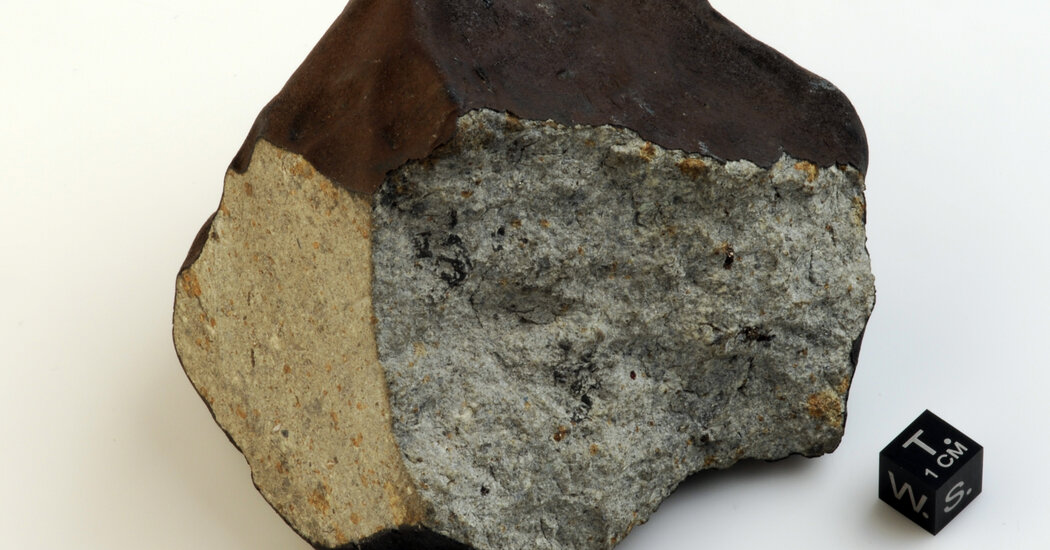Tens of thousands of meteorites have been found on Earth, but the vast majority remain shrouded in mystery. These rocks obviously come from space, but it’s difficult to determine their exact origins, in the solar system or even beyond, without knowing their flight paths.
But now researchers believe they have linked a meteorite discovered decades ago in the Austrian Alps to bright flashes of light from a space rock hurtling through our planet’s atmosphere. It is rare to link a meteorite to its ‘fireball’, and these results demonstrate the usefulness of combining old data sets, the research team suggests. Their findings were published in May in the journal Meteoritics & Planetary Science.
In 1976, Josef Pfefferle, a forest ranger, was clearing the remains of an avalanche near the Austrian village of Ischgl when he noticed a strange-looking rock. He brought the fist-sized black stone back to his house and put it in a box.
Thirty-two years later, Mr. Pfefferle heard a news report about a meteorite discovered in Austria and wondered if his strange rock might also have come from space. He decided to take his stone to a university to be analyzed.
Mr. Pfefferle’s find turned out to be a meteorite, and at a weight of over two pounds, a relatively large one. Furthermore, its unweathered exterior suggested that it had only fallen to Earth shortly before Mr. Pfefferle picked it up.
“It was such a new meteorite,” says Maria Gritsevich, a planetary scientist at the University of Helsinki in Finland, who led the recent study. “It was so well preserved.”
Dr. Gritsevich and her colleagues suspected that if the Ischgl meteorite had fallen to Earth relatively recently, its arrival might have been captured on film. A network of 25 sky-observing cameras spread across southern Germany has been collecting long-exposure images of the night sky since 1966. By the time the network ceased operations in 2022, it had recorded more than 2,000 fireballs.
“It made a lot of sense to trace it back to the most recent fireball observed in the area,” said Dr. Gritsevich.
She and her team searched for negatives of fireball-containing images stored at the German Aerospace Center in Augsburg. After digitizing the images, the researchers estimated various parameters about the incoming meteors, such as their mass, shape, speeds and angles of incidence. Using that data, the researchers focused on a dozen events that most likely produced significant meteorites. Before 1976, only three had occurred.
The team reconstructed the trajectory of each of these three fireballs and calculated where meteorites were likely to be found. There was only one match to the site where the Ischgl meteorite was recovered. This led the researchers to conclude that the fireball that arced low over the horizon in the early morning hours of November 24, 1970 gave birth to the Ischgl meteorite.
“This one matched exactly,” said Dr. Gritsevich.
She and her colleagues calculated that the incoming meteor fell to Earth at a speed of about 70,000 kilometers per hour. That’s fast, but well within the range of meteoroids born in the solar system, said Dr. Gritsevich. In contrast, something coming from outside the solar system would have traveled much faster, she added.
The meteoroid that produced the fireball in 1970 once orbited the sun relatively close to Earth, the team estimated. It probably didn’t come from the main asteroid belt between Mars and Jupiter, which is the source of many meteoroids, said Dr. Gritsevich.
It’s important to link a meteorite to where it was born, says Marc Fries, a planetary scientist at the NASA Johnson Space Center in Houston, who was not involved in the study. “It goes from a rock you find on the ground to a rock that comes from a specific place in the solar system,” he said. So far, the orbits of about 50 meteorites have been determined; Ischgl is the third oldest of them.
However, the case of the Ischgl meteorite is not closed yet, says Peter Brown, a planetary scientist at Western University in Ontario, who was also not involved in the study. After all, there is always the possibility that this meteorite has been on the Earth’s surface for much longer than six years. The alpine environment into which it fell could have preserved the rock quite well.
“It really could have been there for decades and possibly centuries,” said Dr. Brown.
Still, he says there is a great story behind it: “It’s great to show that there is value in this older data.”
